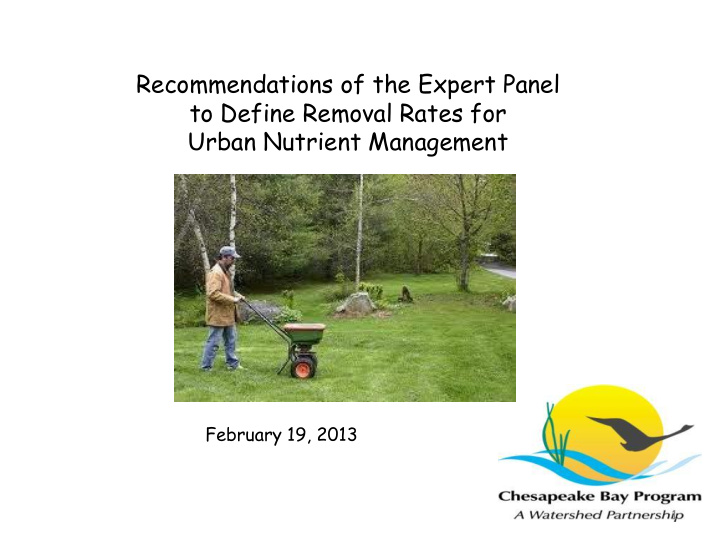



Recommendations of the Expert Panel to Define Removal Rates for Urban Nutrient Management February 19, 2013 1
The Expert Panel Panelist Affiliation Jonathan Champion District Department of the Environment Karl Berger Metropolitan Washington Council of Governments Dr. Stu Schwartz University of Maryland, Baltimore County William Keeling Virginia Department of Conservation and Recreation Dr. Gary Felton University of Maryland, College Park Dr. Neely Law Center for Watershed Protection Marc Aveni Prince William County Department of Public Works Dr. Mike Goatley Virginia Tech Tom Schueler Chesapeake Stormwater Network (panel facilitator) Technical support by Jeremy Hanson (CRC), Molly Harrington (CRC), Gary Shenk (EPA CBPO), Jeff Sweeney (EPA CBPO) and Mark Sievers (TetraTech) is gratefully appreciated 2
Process Dec 17 Roll out Meeting • 45 day comment period • Comments received from: • – MD Dept. of Ag – Agricultural Workgroup – Ches Bay Commission – Gary Felton (panelist) – PA DEP – Industry groups Version 2 released Feb 3, along with response to comments • Seeking USWG endorsement today • 3
Key Issues Debate over Alternative Outreach Option. USWG has 3 options: 1: drop it entirely (cuts in yellow) 2: drop it as a credit, but retain some language on innvoation in Section 7 3: Retain as is Add New Nitrogen Fertilizer Law Credit for MD. • New language on UNM plan verification. • Drop definition and use of conservation landscaping • Edits to core UNM practices • Non-farm fertilizer statistics • 4
Alternative Outreach Alternative methods to motivate property owners or commercial applicators to implement the core UNM practices, such as: Use of local or regional social media/marketing campaigns to • deliver the core message to a geographically defined target population, and encourage them to develop a UNM plan/pledge. Map high risk export factors within a community to target • outreach efforts to develop more UNM plans in these areas Target training to commercial applicators, lawn care companies, • landscape contractors or property managers to encourage them to adopt UNM practices Point of sale outreach at retail sales outlets to encourage UNM • practices Other innovative outreach efforts, as approved by state and/or • extension service. 5
Alternative Outreach (cont.) • The acreage of UNM plans and/or pledges is still the metric for nutrient credit • Sponsoring agencies are eligible for a three year N reduction credit equivalent to 3% of the N load generated for the total pervious area within the geographical area target. • Credit is contingent upon the implementation of a before and after survey to measure actual changes in fertilization behavior outcomes. • After 3 years, the credit is adjusted upwards or downwards based on the actual survey results or UNM plans. 6
The Nitrogen Fertilizer Law Credit • refers to any state legislation or regulations that: (a) limits the N content and establishes minimum slow release content for DIY fertilizer products sold in retail outlets (b) sets an upper limit on the maximum amount of N fertilizer that commercial applicators can apply in any one application (0.9 lbs/acre/year) (c) prohibits application on paved surfaces, water features, or during the dormant season, and, (d) has verifiable procedures for commercial applicator training, certification, and application record-keeping, including fines for non-compliance 7
Commercial applicators in Maryland are now required to • use at least 7 out of the 10 core UNM practices. Consequently, MD is eligible to take the "blended" UNM nitrogen credit (i.e., 9%) for the total acreage of lawns managed by commercial applicators that it can verify as conforming with the new regulations. • Maryland may also receive low risk UNM nitrogen credit • (4.5%) for the acreage of home lawns managed by do-it- yourselfer, as influenced by its new retail sales and labeling requirements.The smaller credit is warranted by the fact that only 4 of the 10 core UNM practices are implemented under this approach (i.e., several practices are still subject to homeowner discretion). 8
Fundamental Reporting Unit: Acres in UNM Plan UNM Plan for 9200 Bradford Pear Lane: 0.5 acres 1 Get Expert Lawn Advice 2 Maintain Dense Cover on Turf 3 Choose NOT to fertilize 4 Recycle Lawn Clippings and Compost Fallen Leaves 5 Correct Fertilizer Timing N/A 6 Use Slow Release Fertilizer N/A 7 Set Mower Height at 3 inches 8 No off-target fertilization N/A 9 Fertilizer free buffer zones around water features 10 Increase soil porosity and infiltration 9
UNM Verification Issues 84,000 farms vs. 4 million lawns • What would on-site UNM • verification actually measure ? Very limited existing • institutional capacity for UNM delivery and verification Residential lawn police ? • Work on issue in the future with • Ag workgroup 10
UNM Verification Issues • 4 million lawns vs. 80,000 farmslans for 1.6 million acres could outstrip capacity of existing UNM delivery system • Several panel recommendations to increase cadre of qualified plan writers 11
Recommend
More recommend